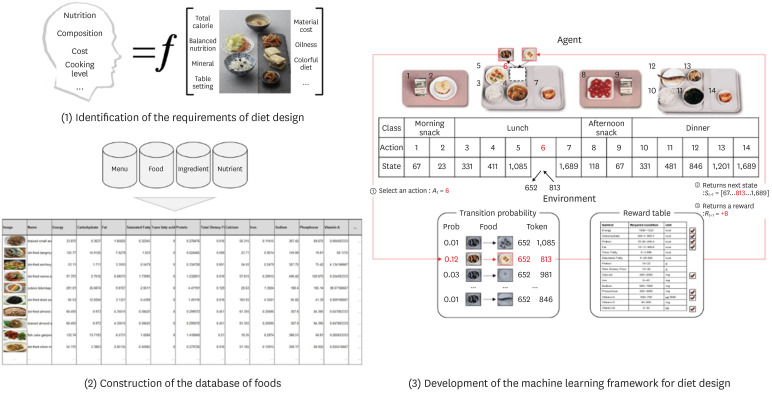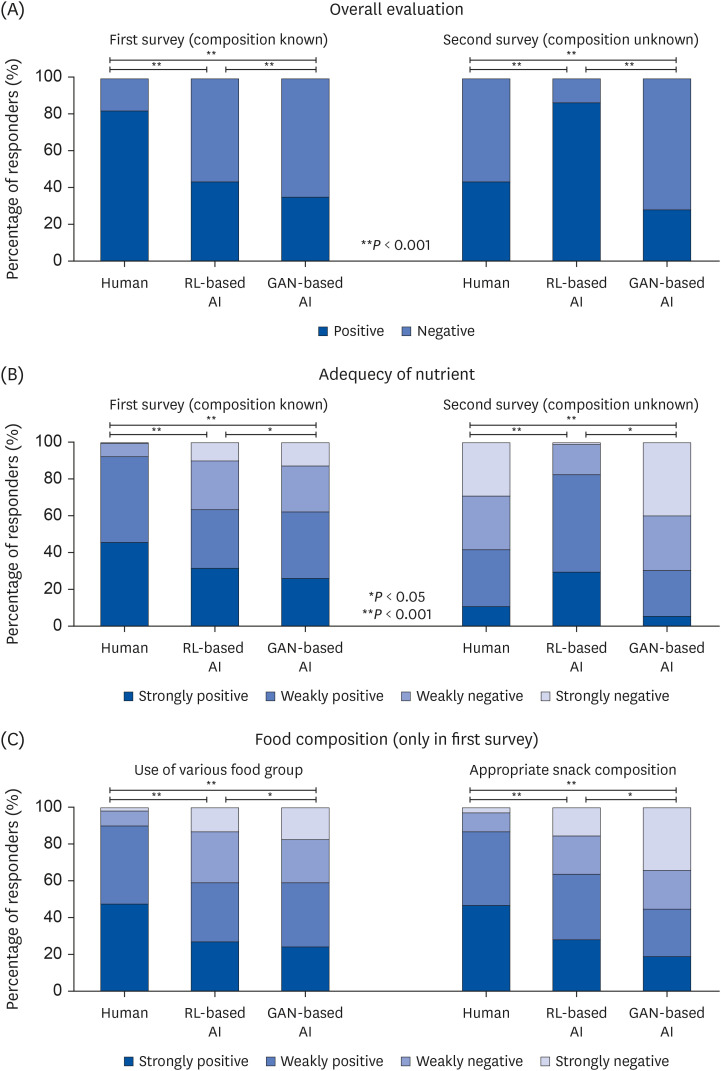Nutr Res Pract.
2022 Dec;16(6):801-812. 10.4162/nrp.2022.16.6.801.
Challenges of diet planning for children using artificial intelligence
- Affiliations
-
- 1Department of Industrial Engineering, Ulsan National Institute of Science and Technology (UNIST), Ulsan 44919, Korea
- 2Kosin Innovative Smart Healthcare Research Center, Kosin University Gospel Hospital, Busan 49267, Korea
- 3Graduate School of Artificial Intelligence, Ulsan National Institute of Science and Technology (UNIST), Ulsan 44919, Korea
- 4Department of Pediatrics, Kosin University Gospel Hospital, Kosin University College of Medicine, Busan 49267, Korea
- KMID: 2536513
- DOI: http://doi.org/10.4162/nrp.2022.16.6.801
Abstract
- BACKGROUND/OBJECTIVES
Diet planning in childcare centers is difficult because of the required knowledge of nutrition and development as well as the high design complexity associated with large numbers of food items. Artificial intelligence (AI) is expected to provide diet-planning solutions via automatic and effective application of professional knowledge, addressing the complexity of optimal diet design. This study presents the results of the evaluation of the utility of AI-generated diets for children and provides related implications.
MATERIALS/METHODS
We developed 2 AI solutions for children aged 3–5 yrs using a generative adversarial network (GAN) model and a reinforcement learning (RL) framework. After training these solutions to produce daily diet plans, experts evaluated the human- and AI-generated diets in 2 steps.
RESULTS
In the evaluation of adequacy of nutrition, where experts were provided only with nutrient information and no food names, the proportion of strong positive responses to RLgenerated diets was higher than that of the human- and GAN-generated diets (P < 0.001). In contrast, in terms of diet composition, the experts’ responses to human-designed diets were more positive when experts were provided with food name information (i.e., composition information).
CONCLUSIONS
To the best of our knowledge, this is the first study to demonstrate the development and evaluation of AI to support dietary planning for children. This study demonstrates the possibility of developing AI-assisted diet planning methods for children and highlights the importance of composition compliance in diet planning. Further integrative cooperation in the fields of nutrition, engineering, and medicine is needed to improve the suitability of our proposed AI solutions and benefit children’s well-being by providing high-quality diet planning in terms of both compositional and nutritional criteria.
Keyword
Figure
Reference
-
1. Larson N, Ward DS, Neelon SB, Story M. What role can child-care settings play in obesity prevention? A review of the evidence and call for research efforts. J Am Diet Assoc. 2011; 111:1343–1362. PMID: 21872698.
Article2. Gubbels JS, Kremers SP, Stafleu A, Dagnelie PC, de Vries NK, Thijs C. Child-care environment and dietary intake of 2- and 3-year-old children. J Hum Nutr Diet. 2010; 23:97–101. PMID: 19943841.
Article3. Yoong SL, Grady A, Wiggers JH, Stacey FG, Rissel C, Flood V, Finch M, Wyse R, Sutherland R, Salajan D, et al. Child-level evaluation of a web-based intervention to improve dietary guideline implementation in childcare centers: a cluster-randomized controlled trial. Am J Clin Nutr. 2020; 111:854–863. PMID: 32091593.
Article4. Schwarzenberg SJ, Georgieff MK. Committee on Nutrition. Advocacy for improving nutrition in the first 1000 days to support childhood development and adult health. Pediatrics. 2018; 141:e20173716. PMID: 29358479.
Article5. Goldbohm RA, Rubingh CM, Lanting CI, Joosten KF. Food consumption and nutrient intake by children aged 10 to 48 months attending day care in The Netherlands. Nutrients. 2016; 8:E428.
Article6. Gillman MW. Early infancy - a critical period for development of obesity. J Dev Orig Health Dis. 2010; 1:292–299. PMID: 25141932.
Article7. Spence A, Love P, Byrne R, Wakem A, Matwiejczyk L, Devine A, Golley R, Sambell R. Childcare food provision recommendations vary across Australia: Jurisdictional comparison and nutrition expert perspectives. Int J Environ Res Public Health. 2020; 17:6793. PMID: 32957687.
Article8. Benjamin Neelon SE, Briley ME. American Dietetic Association. Position of the American Dietetic Association: benchmarks for nutrition in child care. J Am Diet Assoc. 2011; 111:607–615. PMID: 21443997.
Article9. Ishida H. Role of school meal service in nutrition. J Nutr Sci Vitaminol (Tokyo). 2015; 61(Suppl):S20–S22. PMID: 26598858.
Article10. Matwiejczyk L, Mehta K, Scott J, Tonkin E, Coveney J. Characteristics of effective interventions promoting healthy eating for pre-schoolers in childcare settings: An umbrella review. Nutrients. 2018; 10:293. PMID: 29494537.
Article11. Buscemi J, Kanwischer K, Becker AB, Ward DS, Fitzgibbon ML. Society of Behavioral Medicine Health Policy Committee. Society of Behavioral Medicine position statement: early care and education (ECE) policies can impact obesity prevention among preschool-aged children. Transl Behav Med. 2015; 5:122–125. PMID: 25729461.
Article12. Finch M, Seward K, Wedesweiler T, Stacey F, Grady A, Jones J, Wolfenden L, Yoong SL. Challenges of increasing childcare center compliance with nutrition guidelines: a randomized controlled trial of an intervention providing training, written menu feedback, and printed resources. Am J Health Promot. 2019; 33:399–411. PMID: 30004247.
Article13. Gerritsen S, Wall C, Morton S. Child-care nutrition environments: results from a survey of policy and practice in New Zealand early childhood education services. Public Health Nutr. 2016; 19:1531–1542. PMID: 26466671.
Article14. Seward K, Finch M, Yoong SL, Wyse R, Jones J, Grady A, Wiggers J, Nathan N, Conte K, Wolfenden L. Factors that influence the implementation of dietary guidelines regarding food provision in centre based childcare services: a systematic review. Prev Med. 2017; 105:197–205. PMID: 28965755.
Article15. Wolfenden L, Jones J, Williams CM, Finch M, Wyse RJ, Kingsland M, Tzelepis F, Wiggers J, Williams AJ, Seward K, et al. Strategies to improve the implementation of healthy eating, physical activity and obesity prevention policies, practices or programmes within childcare services. Cochrane Database Syst Rev. 2016; 10:CD011779. PMID: 27699761.
Article16. Grady A, Seward K, Finch M, Wolfenden L, Wyse R, Wiggers J, Lecathelinais C, Yoong SL. A three-arm randomised controlled trial of high- and low-intensity implementation strategies to support centre-based childcare service implementation of nutrition guidelines: 12-month follow-up. Int J Environ Res Public Health. 2020; 17:4664. PMID: 32610487.
Article17. Sevilla WM. Nutritional considerations in pediatric chronic disease. Pediatr Rev. 2017; 38:343–352. PMID: 28765197.
Article18. Kliegman RM, St. Geme J. Nelson Textbook of Pediatrics. Amsterdam: Elsevier Inc.;2020.19. Grady A, Wolfenden L, Wiggers J, Rissel C, Finch M, Flood V, Salajan D, O’Rourke R, Stacey F, Wyse R, et al. Effectiveness of a web-based menu-planning intervention to improve childcare service compliance with dietary guidelines: randomized controlled trial. J Med Internet Res. 2020; 22:e13401. PMID: 32014843.
Article20. Reeves P, Edmunds K, Szewczyk Z, Grady A, Yoong SL, Wolfenden L, Wyse R, Finch M, Stacey F, Wiggers J, et al. Economic evaluation of a web-based menu planning intervention to improve childcare service adherence with dietary guidelines. Implement Sci. 2021; 16:1. PMID: 33413491.
Article21. Eckstein E. Is the “diet problem” identical to the “menu planning problem”? Manage Sci. 1970; 16:527–528.22. Ledig C, Theis L, Huszár F, Caballero J, Cunningham A, Acosta A, Aitken A, Tejani A, Totz J, Wang Z, et al. Photo-realistic single image super-resolution using a generative adversarial network. In : 2017 IEEE Conference on Computer Vision and Pattern Recognition (CVPR); 2017 July 21–26; Honolulu, Hawaii. Manhattan (NY): IEEE;2017. p. 105–114.23. Sutton RS, Barto AG. Reinforcement Learning: An Introduction. Cambridge (MA): MIT Press;2018.24. Ducrot P, Méjean C, Aroumougame V, Ibanez G, Allès B, Kesse-Guyot E, Hercberg S, Péneau S. Meal planning is associated with food variety, diet quality and body weight status in a large sample of French adults. Int J Behav Nutr Phys Act. 2017; 14:12. PMID: 28153017.
Article25. Thurecht RL, Pelly FE, Cooper SL. Dietitians’ perceptions of the healthiness of packaged food. Appetite. 2018; 120:302–309. PMID: 28866030.
Article26. Montagnese C, Santarpia L, Buonifacio M, Nardelli A, Caldara AR, Silvestri E, Contaldo F, Pasanisi F. European food-based dietary guidelines: a comparison and update. Nutrition. 2015; 31:908–915. PMID: 26015390.
Article27. Reddy SA, Anitha M. Culture and its influence on nutrition and oral health. Biomed Pharmacol J. 2015; 8.
Article28. Kim SH, Kim MS, Lee MS, Park YS, Lee HJ, Kang SA, Lee HS, Lee KE, Yang HJ, Kim MJ, et al. Korean diet: characteristics and historical background. J Ethn Foods. 2016; 3:26–31.
Article29. Gabriel AS, Ninomiya K, Uneyama H. The role of the Japanese traditional diet in healthy and sustainable dietary patterns around the world. Nutrients. 2018; 10:173. PMID: 29401650.
Article30. Roman B, Russell S. Southeast Asian food and culture [Internet]. DeKalb (IL): Northern Illinois University;2009. cited 2021 August 8. Available from: https://www.niu.edu/clas/cseas/_pdf/lesson-plans/k-12/southeast-asian-food-culture.pdf.31. Zeevi D, Korem T, Zmora N, Israeli D, Rothschild D, Weinberger A, Ben-Yacov O, Lador D, Avnit-Sagi T, Lotan-Pompan M, et al. Personalized nutrition by prediction of glycemic responses. Cell. 2015; 163:1079–1094. PMID: 26590418.
Article32. Loh W, Tang ML. The epidemiology of food allergy in the global context. Int J Environ Res Public Health. 2018; 15:2043. PMID: 30231558.
Article33. Schürmann S, Kersting M, Alexy U. Vegetarian diets in children: a systematic review. Eur J Nutr. 2017; 56:1797–1817. PMID: 28299420.
Article34. Venter C, Laitinen K, Vlieg-Boerstra B. Nutritional aspects in diagnosis and management of food hypersensitivity-the dietitians role. J Allergy (Cairo). 2012; 2012:269376. PMID: 23150738.
Article35. Venter C, Groetch M, Netting M, Meyer R. A patient-specific approach to develop an exclusion diet to manage food allergy in infants and children. Clin Exp Allergy. 2018; 48:121–137. PMID: 29315948.
Article36. Melina V, Craig W, Levin S. Position of the academy of nutrition and dietetics: vegetarian diets. J Acad Nutr Diet. 2016; 116:1970–1980. PMID: 27886704.
Article37. Stein K. Remote nutrition counseling: considerations in a new channel for client communication. J Acad Nutr Diet. 2015; 115:1561–1576. PMID: 26271692.
Article38. Fakih El Khoury C, Karavetian M, Halfens RJ, Crutzen R, Khoja L, Schols JM. Effects of dietary mobile apps on nutritional outcomes in adults with chronic diseases: a systematic review and meta-analysis. J Acad Nutr Diet. 2019; 119:626–651. PMID: 30686742.
Article39. Matheny ME, Whicher D, Thadaney Israni S. Artificial intelligence in health care: a report from the national academy of medicine. JAMA. 2020; 323:509–510. PMID: 31845963.40. Lee C, Kim S, Lim C, Kim J, Kim Y, Jung M. Diet planning with machine learning: teacher-forced REINFORCE for composition compliance with nutrition enhancement. In : 27th ACM SIGKDD Conference on Knowledge Discovery & Data Mining; 2021 August 14–18; Singapore. New York (NY): Association for Computing Machinery;2021. p. 3150–3160.41. Lee C, Kim S, Jeong S, Lim C, Kim J, Kim Y, Jung M. MIND dataset for diet planning and dietary healthcare with machine learning: dataset creation using combinatorial optimization and controllable generation with domain experts. In : Thirty-fifth Conference on Neural Information Processing Systems (NeurIPS) Datasets and Benchmarks Track; 2021 December 6–14; La Jolla (CA): Neural Information Processing Systems Foundation;2021. p. 1–13.
- Full Text Links
- Actions
-
Cited
- CITED
-
- Close
- Share
- Similar articles
-
- Clinical significance, challenges and limitations in using artificial intelligence for electrocardiography‑based diagnosis
- Artificial Intelligence in Pathology
- Future Perspectives of Artificial Intelligence in Mental Health Care: Challenges and Opportunities
- Concepts, Characteristics, and Clinical Validation of IBM Watson for Oncology
- Artificial Intelligence in Lymph Node Metastasis Prediction for T1 Colorectal Cancer: Promise and Challenges




